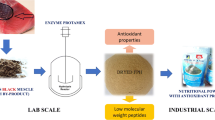Abstract
Free and total histidine contents in the muscle of various fishes and invertebrates caught in the Seto Inland Sea were estimated. These contents were higher in the muscles from skipjack, yellowfin tuna, yellowtail and mackerel than in those from lizard fish, sea bream and hairtail. Invertebrate muscles, except squid, contained low free and total histidine. Boiled and dried anchovy (niboshi) contained lower free histidine than that of dried anchovy (suboshi). To prepare free histidinerich extracts, the waste residue of soup stock from smoke-dried and shaved skipjack (katsuobushi) was digested with proteases. The extract of the enzyme digest contained high free histidine and was used to fortify niboshi with free histidine. If taken, the fortified niboshi may suppress food intake, and prevent obesity.
Similar content being viewed by others
References
Sakata T. An appetite and marine products. In: Yamazawa M, Seki N, Okuda H, Takeuchi M, Fuke S (eds). Suisanshokuhin-No-Kennkouseikinou. (Health Functions of Marine Foods). Koseishakoseikaku, Tokyo. 2001; 15–27 (in Japanese).
Sakata T, Yoshimatu H, Kurokawa M. Hypothalamic neuronal histamine: implications of its homeostatic control of energy metabolism. Nutrition 1997; 13: 403–411.
Kang M, Yoshimatu H, Chiba S. Hypothalamic neuronal histamine modulate physiological responses induced by interleukin-1β. Am. J. Physiol. 1995; 269: 1308–1313.
Fukagawa K, Knight DS, Price HV. Transplantation of lean fetalhypothamus restores hypothalamic function in zucker obese rates. Am. J. Physiol. 1996; 271: 55–63.
Yoshimatsu H, Hideka S, Niijima A, Sakata T. Histamine neurons down-regulate ob gene expression in rat white adipose tissue. Inflamm. Res. 2001; 50: 72–73.
Masaki T, Yoshimatsu H, Chiba S, Watanabe T, Sakata T. Central infusion of histamine reduces fat accumulation and up-regulates UCP family in leptin-resistant obese mice. Diabetes 2001; 50: 376–384.
Yoshimatu H, Chiba S, Tajima D, Akehi Y, Sakata T. Histamine suppresses food intake through its conversion into neuronal histamine. Exp. Biol. Med. 2002; 227: 63–68.
Yoshimatsu H, Tsuda K, Niijima A, Tatsukawa N, Chiba S, Sakata T. Histidine induces lipolysis through sympathetic nerve in white adipose tissue. Eur. J. Clin. Invest. 2002; 32: 236–241.
Schwarz JC, Lampart C, Rose C, Rehault MC, Bischoff S, Pollard H. Histamine formation in rat brain during development. J. Neurochem. 1971; 18: 1787–1789.
Taylor KM, Snyder SH. Isotopic microassay of histamine, histidine, histidine decarboxylase and histamine methyltransferase in brain tissue. J. Neurochem. 1972; 19: 1343–1353.
Nakajima S, Hamada M, Tsuchiya T, Okuda H. Inhibitory effect of niboshi on food intake. Fish. Sci. 2000; 66: 795–797.
Nakajima S, Tanaka K, Hamada M, Tsuchiya T, Okuda H. Correlation between energy and histidine intake in female living in Setouchi area. J. Jpn. Soc. Study Obesity. 2001; 7: 276–282.
Nakajima S, Kasaoka S, Inoue S, Katoh H, Kawahara Y, Tsuchiya T, Okuda H. Suppressive effect of histidine on food intake in rats using cafeteria method. J. Jpn. Soc. Study Obesity. 2002; 8: 55–60.
Kasaoka S, Nakajima S, Inoue S, Katoh H, Kawahara Y, Tsuchiya T, Okuda H. Reduction of triglyceride in liver of rats fed the 0.4% histidine diet for 3 weeks. J. Jpn. Soc. Study Obesity. 2002; 8: 168–172.
Tsuji M, Nakajima S, Tanaka K, Kasaoka S, Tsuchiya T, Okuda H. Correlation between BMI and histidine intake. J. Jpn. Soc. Study Obesity. 2002; 8: 302–305.
Nakajima S, Hamada M, Tsuchiya T, Okuda H. Suppression of food intake by histidine-rich protein under low energy intake. J. Jpn. Soc. Nutr. Food Sci. 2000; 53: 207–214.
Nakajima S, Tanaka K, Kasaoka S, Tsuji M, Tsuchiya T, Okuda H. Correlation between histidine intake and food intake. J. Jpn. Soc. Study Obes. 2004; 10: 66–72.
Resources Council, Science and Technology Agency, Japan. Amino acid composition of foods. In: Standard Table of Food Composition in Japan, Revised edition. Ministry of Finance, Printing Bureau, Tokyo. 1986. (in Japanese).
Tsuji M, Kasaoka S, Tsuchiya T, Okuda H, Nakajima S. Correlation between body fat and histidine intake. J. Jpn. Soc. Study Obes. 2004; 10: 173–176.
Author information
Authors and Affiliations
Corresponding author
Rights and permissions
About this article
Cite this article
Hiraoka, Y., Sasaki, Y., Takai, T. et al. Fortification of niboshi with histidine prepared from katsuobushi protein digest. Fish Sci 73, 1383–1387 (2007). https://doi.org/10.1111/j.1444-2906.2007.01481.x
Received:
Accepted:
Issue Date:
DOI: https://doi.org/10.1111/j.1444-2906.2007.01481.x




